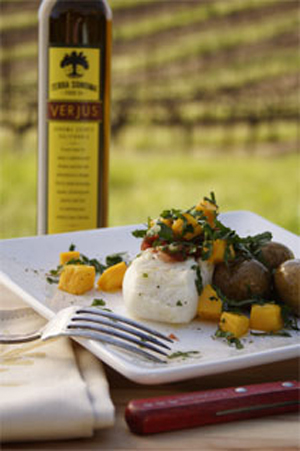 |

 |
A plump piece of verjus-sauced halibut with oven-roasted yellow beets and potatoes, garnished with crisp bacon and a chiffonade of basil. Photography courtesy Terra Somona. |
| WHAT IT IS: The fresh juice from wine grapes that has not been fermented into vinegar. |
| WHY IT’S DIFFERENT: It provides tartness without the acidity. |
WHY WE LOVE IT: It’s distinctively delicious and very low in calories. |
| WHERE TO BUY IT: TerraSonoma.com. |
|
|
 |
 Page 2: Verjus History Page 2: Verjus History
This is Page 2 of a three-page review, plus recipes. Click on the black links below to visit other pages.
INDEX OF REVIEW
MORE TO DISCOVER
|
Verjus History
Grapes have been grown for more than 3,000 years. As farmers became more skilled viticulturists, they realized the need to thin out the vines for better wine-making (fewer grapes allow more concentration of flavor in those grapes, as opposed to a larger quantity of grapes harvested with more dilute flavor). When looking for a use for the unripe grapes that had been trimmed, verjus was the happy result.
Though it achieved a peak of popularity during medieval times, the oldest reference to verjus in a recipe dates to 71 C.E. Roman cooking included three different types of grape juice:
- Grape Juice Syrup: A fresh, pressed grape juice was cooked down to a concentrated syrup and used as a recipe ingredient. This style evolved into modern balsamic vinegar.
- Wine: Freshly-fermented wine that was used in recipes as well as drunk.
- Verjus: Unripe, tart pressed grape juice that the Romans called acresta, meaning acrid (verjus is French word). By the Middle Ages, the Roman word had become agresto in Italian, the word still used today. (The Spanish and Germans use another variation, agraz.)
The Romans brought these three foods—along with many others—as their empire spread north through much of Europe. Verjus was largely a summer ingredient, since it was freshly pressed and as a fresh juice, it had a short shelf life. (Vinegar, which can be stored almost in perpetuity, was used during the other months.)
By 300 C.E., both fermented and unfermented grape juice—fresh wine and verjus—appeared in numerous recipes. The city of Dijon (which began life as a Roman settlement called Divio) became the mustard-making center, since both mustard fields and vineyards were plentiful in what is now known as Burgundy. Ground mustard seed was mixed with wine or verjus to make prepared mustard.*
*Mustard = must, another word for unfermented grape juice (verjus) + ard, from the Latin word for fiery or spicy, ardens.
The next major word on verjus comes during the late Middle Ages. Bartolomeo Sacchi (1421-1481), wrote De honesta voluptate et valetudin, (“On honourable pleasure and health”) under his pseudonym, Il Plàtina. Considered the first printed cookbook in Europe, written around 1465 and printed 10 years later. (You can find out-of-print English translations on Amazon.com.) Many of the recipes are from Maestro Martino de Rossi, a famous chef of the day.
In article 26 he writes:
| |
26. ON VERJUICE
What they commonly call acresta, I would call omphacium, on the authority of Pliny, and acor [verjuice], on the authority of Macrobius,** for omphax, as I have said, means a still-bitter grape; therefore, I would rather call oil from an unripe berry omphacium than acresta, which I do not quite see as being from omphax. [Macrobius] thus defines verjuice: vinegar is sharper than verjuice, whose force it is agreed is greater than acresta, which soothes the burning of the stomach more mildly and does not emaciate or weaken the body as vinegar is apt to do. Verjuice is wonderfully good for an unsettled or upset stomach or thirsty liver, if you use it raw, for it is less helpful cooked. We use it easily and healthfully against poison and in seasoning foods.
**Ambrosius Theodosius Macrobius was a Roman writer and philosopher who worked primarily during the period 395-423 C.E. |
|

Bartolomeo Sacchi, Il Plàtina. Photo courtesy Summagallicana.it. |
When it was printed in 1475, Plàtina offered the original manuscript to Pope Sixtus IV. It was accepted and is preserved in the Vatican library. The pope then appointed Platina to the position of prefect of the Vatican library.
Continue To The Next Page: How Verjus Is Made
Go To The Article Index Above
Do you have friends who would enjoy THE NIBBLE?
Click here to send them an invitation to sign up for their own copy. |
© Copyright 2004-2025 Lifestyle Direct, Inc. All rights
reserved. All information contained herein is subject to change at any time
without notice. All details must be directly confirmed with manufacturers, service
establishments and other third parties. The material in this e-zine may not
be reproduced, distributed, transmitted, cached, or otherwise used, except with
the prior written permission of Lifestyle Direct, Inc.
|
|

|
 |